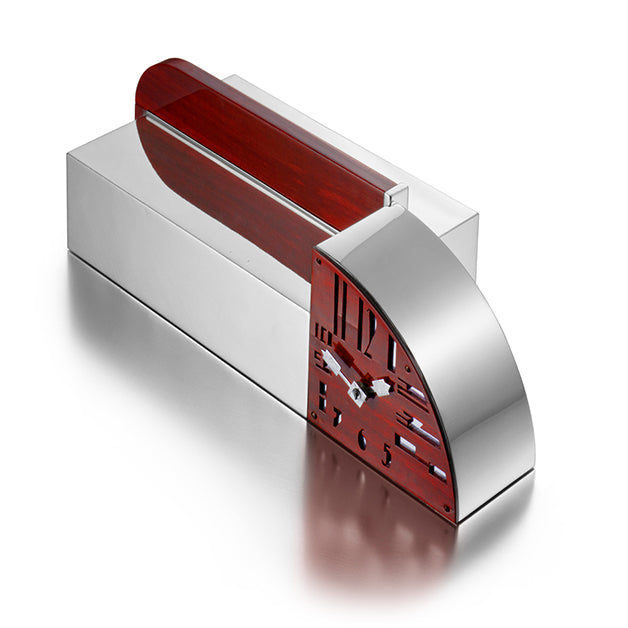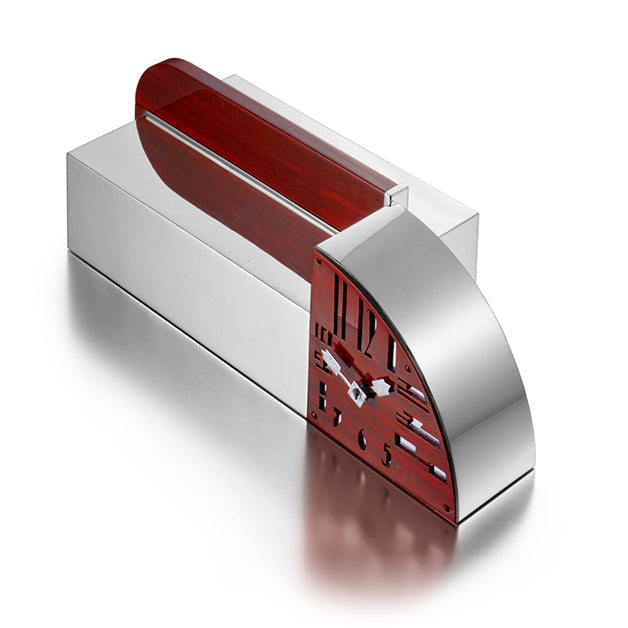ART MODERNE CLOCK BY JEAN PUIFORCAT, FRANCE, CIRCA 1930
ART MODERNE CLOCK BY JEAN PUIFORCAT, FRANCE, CIRCA 1930
SOLD: Acquired by the Cincinnati Art Museum
A clock composed of a wedge-shape clock face, the stylized numbers created by cut-outs in wood veneer laid over metal, the clock face sided by a drawer originally for cigarettes enhanced with a wood fin; mounted in nickel-plated brass
- Movement stamped A R and 1729, inside case stamped 1729, bottom of case stamped 1729, manufactured by Hour-Lavigne
Additional cataloguing
Literature
- cf. de Bonneville, Françoise. Jean Puiforcat. Paris: Editions du Regard, 1986, p. 311.
Biography
Born in 1897 to a family of French cutlery silversmiths dating to 1820, Jean Puiforcat served in World War I before joining the family firm and creating the strong geometric designs composed of flat surfaces in dynamic combinations that he is known for. In 1928 he co-founded the Union des Artistes Modernes with Raymond Templier, Jean Fouquet, René Herbst, and Gérard Sandoz before moving to Mexico in 1941 and dying unexpectedly in 1945. The company is now owned by Hermès.
Significance
The 1920s and 1930s were a time of great technological advancement both on land and in the sky. The excitement of this new technology was reflected in the bold streamlined shapes of the late Art Deco, known as Art Moderne. Coming off the curves and elaborate decoration of previous decades, the straight lines of the Art Deco were modern and shocking. Jean Puiforcat, a founder of the Union des Artistes Modernes, was a master of the austere and inventive. He wrote in a report of the Admissions Committee for the 1925 Exposition internationale des arts décoratifs et industriels modernes, “a teapot must pour correctly and thus accomplish its function” but it is also a “work of art and must, within its modest sphere, uplift the soul with its beauty.”
Puiforcat was featured prominently at the 1925 exhibition from which Art Deco draws its name and exhibited in Jacques-Émile Ruhlmann’s Pavilion of a Rich Collector. His designs were celebrated by critics, artists, and collectors as some of the finest of the era. Gaston Varenne wrote in Art & Decoration that the pieces “all possess a great purity of line and volume whose coldness is attenuated by the subtle shift of cleverly architectured surfaces and occasional veins. The uses of exotic stones and wood add a note of color.” Rather than being created with exalted materials, the rigorous objects designed by Puiforcat are luxurious in the precision and quality of their conception and design.
Raymond Templier described Puiforcat’s work as “displaying a reasoning, a logic, a robustness and highly sensitive precision. He was able to magnificently create forms of astonishing invention and logic, achieving true equilibrium, joy, and perfect visual harmony.” Heavily influenced by mathematics and the golden section, in this clock, Puiforcat designed an austere, streamlined piece composed of polished metal and rich warm rosewood. Bold geometric shapes slide together and interconnect creating this elegant desk clock with drawer. Puiforcat insisted that all his pieces must be made completely by hand, but no hammer strike is ever visible, achieving perfection. This desk clock is a magnificent and pure example of the Art Deco.



